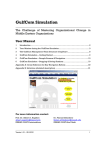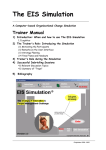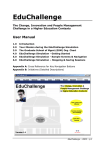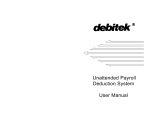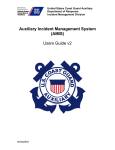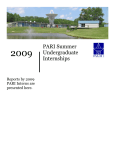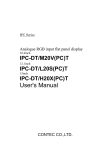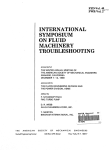Download GulfCom User Manual
Transcript
GulfCom Simulation The Challenge of Mastering Organizational Change in Middle Eastern Organizations User Manual 1 Introduction ........................................................................................................2 2 Your Mission during the GulfCom Simulation ......................................................3 3 The GulfCom Management Team Structure (OrgChart) ......................................8 4 GulfCom Simulation – Getting Started .................................................................9 5 GulfCom Simulation – Sample Screens & Navigation .........................................10 6 GulfCom Simulation – Stopping & Saving Sessions ............................................19 Appendix A: Cross Reference for Key Navigation Buttons ........................................20 Appendix B: Initiatives (detailed description) ..........................................................21 For more information contact: Prof. Dr. Albert A. Angehrn [email protected] INSEAD CALT Fontainebleau Version 0.91 – 31.5.2009 Dr. Florian Schloderer [email protected] INSEAD CALT Abu Dhabi 1 1 Introduction In the “GulfCom Simulation”, you will be challenged to introduce an innovation in a subsidiary (GulfCom) of Al Saqr Investments. Your mission, as formulated by the Headquarters of Al Saqr, is to spend the next 6 months trying to convince the GulfCom top management team to adopt the groups Performance Management System (PMS) which will increase consistency, transparency and performance corporate-wide. As displayed in the enclosed screens of the simulation, you will be able to choose among many different initiatives to meet your goal. In some cases, you may gather information on the managers (for example who drinks coffee with whom, etc.). In other cases, you may take direct action to try to convince the managers and thus influence their willingness to adopt the proposed innovation. Each time you implement an initiative, you will receive feedback about the impact of your decision immediately. The objective is to get as many adopters as possible in the shortest time. The following screens illustrate in more detail the purpose and the main elements of the GulfCom Simulation, and explain the navigation of the screens, should you have any difficulty. Start by reading the Mission (Section 2) to better understand the context in which you and your team will operate. The rest of the manual (Section 3-6) just explains in more detail the user interface of the software you will be using during your mission. Version 0.91 – 31.5.2009 2 2 Your Mission during the GulfCom Simulation First, review your mission by clicking on the ‘Mission’ button in the upper right oval box of the screen. You will then access the ‘Mission’ screen which has 4 buttons called “The Context”, “The Project”, “Your Challenge” and “How to go about it”. The information you will access is shown in the following four screens. You and your team have just been appointed by the CEO of Al Saqr Investments to a challenging change management mission: Over the next 6 months you will be operating at GulfCom, a recently acquired fast growing company. Your objective there is to persuade a successful but very independent-minded top management team to harmonize their performance management processes and systems to the ones of the whole group by adopting the corporate Performance Management System (PMS). Al Saqr Investments, your company, is a global business development and investment group, which over the last 10 years grew and expanded tremendously through entering new markets and through the acquisition of companies like GulfCom, which joined the group almost 2 years ago. In fact, Al Saqr Investments is a leading business development and investment group founded in 1975. Located in an oil and gas producing country at the Arab Gulf, Al Saqr Investments is a semi-public enterprise and is controlled by one of the members of the local ruling family. The profits from high oil and gas prices in recent years have allowed the group to grow at a very fast pace through acquisitions, and today it owns a big portfolio of companies from industries as diverse as construction, automotive and information technology. Al Saqr Investments pursues a long-term investment strategy, promoting sustainable growth and profitability of its subsidiaries. To implement this strategy, a performance management system (PMS) has been introduced throughout the group. Version 0.91 – 31.5.2009 3 GulfCom is the most successful recent acquisition of Al Saqr Investments. It is considered by everybody as “cash cow” of the whole group, and is run proudly and independently Dr. Khalid, the CEO, and his management team. In fact, GulfCom is a local telecommunication company based in one of the countries around the Arab Gulf and owned by a local shareholder group. Like in most other companies of this region, decision making is very centralized, i.e. GulfCom operates essentially according to the decisions of its longtime CEO, Dr. Khalid. A few years ago GulfCom has decided to expand its operations to a number of countries throughout the region. The implementation of this strategy required two very costly investments: acquiring an operator’s license and setting-up the technical infrastructure. To finance this expansion strategy, the previous shareholders of GulfCom decided to look for a strategic investor. After negotiating with various investors, 60% of GulfCom’s shared were sold to Al Saqr Investments. PMS is the name of the intranet-based performance management system Al Saqr Investments has deployed over the last 2 years to make sure that goals are set consistently and monitored continuously group-wide. It is said to be the “backbone” of the whole group, providing “everybody with the information they need to make good decisions and focus on what really matters for the group”, as well as a way for everybody to report data and monitor the achievements of goals regularly and systematically. Over the last two years the PMS has been deployed successfully groupwide and adopted by all the companies controlled by Al Saqr Investments except GulfCom, where the CEO – Dr. Khalid – has systematically delayed its implementation in spite of the repeated requests of Al Saqr Investment’s Headquarters. In general terms, a Performance Management System (PMS) is a set of management and analytic processes, supported by technology, that enable businesses to define strategic goals and then measure and manage performance against those goals. Core processes Version 0.91 – 31.5.2009 4 include financial and operating planning, consolidation and reporting, business modeling, analysis, and monitoring of key performance indicators linked to strategy. Performance Management Systems provide managers of large companies with processes and tools supporting them in setting both personal and departmental goals, and then monitor and report systematically on progress towards the achievement of those goals. At the same time, they change the internal reporting system introducing the transparency necessary to aggregate data corporate-wide and allow top managers to answer questions like “How are we performing in this region/sector?” “Which department or sales office is less efficient?” “Based on actual performance trends, which know-how and best practice should be exchanged or transferred among business units?”, etc. The fact that GulfCom has not adopted the PMS system yet is extremely disturbing for the headquarter. Such systems need to be adopted consistently by everybody in order to really increase overall performance, as otherwise information cannot be consolidated at the top. For GulfCom, adopting the group PMS represents a significant change and departure from the systems and processes they had deployed and used successfully before being acquired by Al Saqr Investments. At the time of the acquisition, Dr. Khalid indicated lots of enthusiasm for integrating all the processes of his company to the ones of the group, but since then GulfCom did not change a lot its way of operating. At the time of the acquisition, the CEO of Al Saqr Investments agreed to leave GulfCom’s top management team in place because it had managed the company very successful in the past. However, he insisted that some of Al Saqr’s best practices should be introduced at GulfCom. As a result, each manager has been assigned full and sole responsibility for the performance of his department. Al Saqr Investments also considers it essential that each of the senior managers sets and adopts both personal and departmental goals, and should start using the corporate Performance Management Version 0.91 – 31.5.2009 5 System (PMS) to monitor and report on progress towards the achievement of those goals. Two years later, in particular, all the attempts of the Headquarter to introduce the PMS at GulfCom have failed until now. Sending information about the advantages of the corporate PMS and news about is successful adoption in other subsidiaries didn’t help. Dr. Khalid seemed simply too busy running his successful company to have time for introducing such a new system. The “excuses” he presented (lack of time and resources, other priorities, etc.) have, thus, slowed-down and hindered the efficient rollout of the PMS group-wide. In summary, after many unsuccessful attempts your challenge now is to persuade the CEO of GulfCom, Dr. Khalid, and his top management team to finally adopt the PMS and harmonize their processes and systems to the ones of the whole group. The Headquarter has given you up to 6 months (120 days) for this project. During this time, you will be able to: § Gather information about the management team of the company, § Implement different change management initiatives, § Continuously monitor your progress in helping the 24 members of the management team to move through the phases of AWARENESS, INTEREST, TRIAL and finally ADOPTION of this innovation. Your and your team’s personal objective is to get as many adopters as possible! This is the way your performance will be evaluated by the Headquarter at the end of the 6 months. Attention: The personal assistant of the CEO, Mr. Hazim, and the external financial controller, Mr. Rushd, have no personal objectives related to the company’s performance and are not required to use the PMS. Hence the maximum number of adopters you can reach is 22. Version 0.91 – 31.5.2009 6 Changing the way people think and behave in organizations is not a simple task and often requires a combination of different tactics to be used at the right time with the right people. This simulation will make it possible for you to experiment with the implementation of different types of change management initiatives. But ultimately your strategy, your change diffusion approach, your capabilities as a team to discover what is most appropriate at GulfCom and how to best persuade this group of managers will determine how successful your intervention will be. Accordingly, before plunging into your first decision, we advise you to: 1. try to understand the context in which you are going to work. Remember that you have been sent there by the group’s Headquarter! 2. review the different initiatives you will be able to launch to change people attitudes! 3. develop a change strategy which will guide you through the project (“top-down“, "bottom-up”, etc.) and write it down! Good luck! Version 0.91 – 31.5.2009 7 3 The GulfCom (OrgChart) Management Team Structure The above screen, ‘Org Chart’, shows what is displayed if you click on the ‘Org. Chart’ button at any time during the simulation once you begin. It is the organizational chart of the management team of GulfCom in which you are expected to introduce your innovation during the next 6 months. The management team of the company consists of 22 managers, an External Financial Controller and the CEO's Personal Assistant. The picture of each person appears when you position the cursor on the name. If you then click on the box, you will also get the profile of that person. You can access this chart at any time during the simulation, and return to where you were in the simulation by clicking the ‘Back to the Action’ button. Version 0.91 – 31.5.2009 8 4 GulfCom Simulation – Getting Started Your second action should be to click on the ‘Strategy’ button in the middle oval box of the screen and summarize the strategy you are planning to adopt. Include any revision you may have during the simulation, for instance, after having gathered more information on the organization and its managers. Click on ‘Back to the Action’ when completed. Version 0.91 – 31.5.2009 9 5 GulfCom Simulation – Sample Screens & Navigation 5.1 Control Panel (Home) On the left hand side of the screen you will see displayed the list of the managers you are trying to convince to adopt the PMS. A variety of information about these managers can be accessed from this “Control Panel” screen (depending on the initiatives you take). A status on what you know about a person can be accessed by placing the cursor over the bubble to the left of the person’s name. A personal profile can be retrieved by clicking on the (i) bubble to the left of the person’s name. The red bars displayed in the box to the right of the managers' names indicate how successful you are being in changing the attitude of each manager in relation to adopting the PMS during the simulation. This is dependent on the initiatives you decide to implement (you will be able to see an overview of these initiatives on the right hand side of the screen). You can see that the managers all go through a cycle of adoption, although at different paces, and can be “not aware”, “aware”, “interested”, have the PMS “on trial” or have “adopted” it. You can access the “Control Panel” anytime to monitor your progress on the top left hand side of the screen. Part of the scoring summary at the end of the simulation is a function of the red bars representing the degree of positive attitude that you have achieved for each manager. Version 0.91 – 31.5.2009 10 5.2 Personal Profiles The left hand side of the above screen shows an example of the personal profile, which can be accessed by clicking on the (i) bubble to the left of the person’s name or clicking on their name from the “Org Chart” screen. You can also switch quickly between Personal Profiles by clicking on the arrows on either side of the person’s image. Access to this information is dependent on the initiatives you have taken. Click the ‘Control Panel’ button on the top left of the screen to return to the list of all managers. Version 0.91 – 31.5.2009 11 5.3 Status The right hand side of the above screen shows a status on what you know about a person. This can be accessed by placing the cursor on the left of the person’s name without clicking. The color reflects the current adoption stage. 5.4 Initiatives Version 0.91 – 31.5.2009 12 On the right hand side of the screen, if you click on the ‘Initiatives’ button you will see the above screen, which lists the change management initiatives you may launch during the simulation. A description of a particular initiative will be displayed below this list if you click on any title. You may also click on ‘Detailed Descriptions’ (in the lower half of the right hand screen) and scroll through the descriptions of all initiatives at once (see Appendix A). You may also take a decision from the ‘Initiatives’ screen. To implement an initiative from this screen, highlight the initiative and click on ‘Implement It’. This will bring the “Take Decision” screen up (see 5.5) with the initiative already chosen, and a prompt for any other details you need to provide (ie. the names of people involved). 5.5 Take Decision On the right hand side of the screen, if you click on the ‘Take Decision’ button you will see the above screen, which shows the number of the decision you are about to take. To implement an initiative, click on the “Your initiative” box and select the initiative from the drop down menu that appears. You will also be prompted for any other details you need to provide (ie. Names of people involved). This can be chosen either by clicking on the name of the person on the ‘Control Panel’ (left hand side of screen), or clicking on the box, and selecting the manager (s) from the drop down menu of names. If you make a mistake in choosing the initiative or name, or click on the box with the wrong details in it, select ‘Don’t Do It’ instead of “Implement the Decision’ at the bottom of the screen. For each decision, you should complete the ‘Your rationale for this decision’ box. Finally, click on ‘Implement the Decision’. You will receive immediate feedback on Version 0.91 – 31.5.2009 13 your chosen initiative. You will receive a summary of the outcome, a positive or negative indication of any attitude changes of the managers involved (and maybe not involved), and the clock will continue ticking off along the bottom of the screen (against the 6 months) for the time taken to implement the initiative. 5.6 Networks Click on “Networks” and you can access information regarding the managers: § who has coffee with whom (‘Coffee Breaks’) § who has external links (“External Links”) § who collaborates with whom (“Teams”) Version 0.91 – 31.5.2009 14 5.7 Insights & Issues (Notebook) This Version of the GulfCom Simulation provides the possibility to take notes anytime during a session. This Learning Notebook, accessible by selecting in the upper right side of the screen also provides a structured way to summarize key insights and issues after completing a session. You may fill in the Do’s column on the screen to share “Insights” of what you have learned from the experience as well as Don’ts column for the “Issues” of Change Management you would like to know more about. You are able to print it on paper or on a slide. The content of the Do & Don’ts sheet is recorded in the Session Report. Version 0.91 – 31.5.2009 15 5.8 History Click on ‘History’ at any point during the simulation and you will see a summary of your initiatives to date that you can scroll through. For a detailed history of your Initiatives: Decision #, Initiative, Rationale, Outcome (i.e. the immediate feedback), and No. of Adopters to date – click on ‘History Details’ and scroll through your results. 5.9 Score Version 0.91 – 31.5.2009 16 This shows the score sheet that is displayed if you click the "Score" button located on the bottom middle of the screen. You may click on this at any time to see how you are progressing, and you can return to the simulation by clicking on the buttons at the top of the screen. The thin blue line on the graph (the top one) indicates the cumulative ‘positive attitude’ (i.e. the red bars) you have succeeded in gathering. As you can see in the example in the screen above, the cumulative positive attitude can decrease too during the project, depending on your initiatives and other events that can happen during the 6 months implementation period! The thick red line (the bottom line) indicates the cumulative number of managers you have convinced to adopt. Once someone has adopted they cannot move back through the adoption process. The numeric scores, the number of ‘Days per Adopter’, Elapsed Time, ‘# of Adopters’, and ‘# of Decisions’ ‘# of Attitude Points’ are on the top left of the screen. 5.10 GulfCom Simulation Save Session Report You may save your session’s report at any time during the simulation by clicking on the “Save Session Report” button on the right hand side of the “Score” screen. The report allows you to get details about the session including: the date of running, number of adopters, number of initiatives and the time spent to implement these initiatives and of course the key points of the adopted strategy and also the content of do and don’ts learning points. Beside you will also get all the information on the adoption stage of each person as well as the feedback for each implemented initiative. Version 0.91 – 31.5.2009 17 5.11 GulfCom Simulation Credits Screen This screen provides information about the simulation and those who have contributed to its design, development and continuous updating. It is displayed if you click on the “About” button located on the top right corner of every screen. 5.12 GulfCom Simulation Print The ‘PRINT’ button allows the printing of any page in the Simulation (e.g the SCORE page). In case you print directly on a transparency, you will have to insert the transparency in the printer and choose the appropriate printing options. Version 0.91 – 31.5.2009 18 6 GulfCom Simulation – Stopping & Saving Sessions 6.1 Stopping & Restarting This Version of the EIS Simulation allows you to “stop” a session anytime you want and “resume” it at a later stage. To “stop” the session, just quit the simulation software by clicking on the on the upper right corner of the window. The current session will be automatically saved in the file “Session-XXXX.eis”. To “restart” a session just select …or continue from where you stopped which will appear automatically on the Main Screen the next time you will enter the simulation software. 6.2 Automatic Saving before Quitting a Session This Version of the GulfCom Simulation automatically saves a copy of the session every time you quit the simulation software (in addition to producing the report in editable form). Hence the latest state of the session is always stored in the file “Session-XXXX.eis” and can be reloaded. You can always restart your session from the point you left it by selecting …or continue from where you stopped after restarting. Version 0.91 – 31.5.2009 19 Appendix A: Cross Reference for Key Navigation Buttons Home (Control Panel) Refer 5.1 Org. Chart Refer 3 Networks Refer 5.6 History Refer 5.8 Score Refer 5.9 Strategy Refer 4 Mission Refer 2 Notebook Refer 5.7 About Refer 5.11 Print Refer 5.12 Version 0.91 – 31.5.2009 20 Appendix B: Initiatives (Detailed Description) Get Profiles: Obtain more information about up to five individuals by talking informally with the managers from the HR department of GulfCom. (2 days) NOTE – Each person’s profile includes a qualitative description of the individual and will help you understanding how difficult it will be to help that individual move through the different change phases. The profiles, once gathered, will be available to you during the whole session. Teams: Interview and observe a cross-section of the staff to determine how managers from different parts of the organization collaborate in project teams, task forces or committees (5 days). NOTE – Memberships in collaboration networks will not change, and will remain available throughout the simulation. This information is accessible by clicking on the button “Teams” in the Networks Tab. Coffee Breaks: Spend some time observing in and about the company in order to see which groups of individuals meet regularly over short breaks such as lunch, in the smoking area, or over a coffee. (3 days) NOTE – These groups will not change, and the list will remain available throughout the whole period. This information is available by clicking on the button “Coffee Breaks” in the Networks Tab. External Links: Spend some time observing or finding out which managers share family ties or meet regularly at the local horse race course or at the luxury health clubs & spas. (3 days) NOTE – These groups will not change over the next few months, and the list will remain available throughout the simulation. This information is accessible by clicking on the button “External Links” in the Networks Tab. Internal Magazine: Ask the editor of GulfCom’s internal magazine to include a short article you write on the advantages of advanced Performance Management and their link to transformation in the Gulf area. To be published in the upcoming edition. (3 days) NOTE – This magazine is distributed to all the managers. The article is about the generic advantages of Performance Management Systems & Processes and the features of the Group’s PMS. Face-to-Face Meeting: Fix a meeting with one of the members of GulfCom’s top team in order to persuade him/her that the PMS project would make sense to implement. (1 day) NOTE – The meeting will take place in the person’s office. Public Announcement: Convince the CEO to show his support for your work by publically acknowledging the progress of the PMS project at GulfCom. In a brief email, such a statement could be then forwarded to all the managers. (3 days) NOTE – In the past, only Mr. Hazim, the CEO’s Personal Assistant, had the authority to spread such public statements from the CEO. Electronic Mail: Send a brief electronic mail to everyone on the top management team explaining your ideas on why managing performance with a system like the Group’s PMS makes sense for them, too. (1 day) NOTE – Everybody has an individual e-mail account. Circular: Write and send to any five of the top managers a brief circular on how some of the specific features of the PMS have helped to improve the transparency of information flows at Gulf Automotives, another subsidiary of the Al Saqr Group, and Version 0.91 – 31.5.2009 21 how it could help improve the transparency of information flows at GulfCom, too. (1 day) NOTE – This is distributed in the company’s internal mail system. Dinner Event: Invite one member of the management team to go with you to a gala dinner and award ceremony for outstanding entrepreneurs in the country. This event is under the patronage of the minister of economy. (3 days) NOTE – You are not sure that the manager will accept your invitation and that you will actually be able to find the appropriate opportunity during the dinner to talk to the manager about the PMS project. Informal Encounters: Target one of the members of GulfCom’s management team and try to trigger an “unplanned” brief encounter in order to talk informally about the progress of the PMS project. (2 days) NOTE – You will spend some time in the hallways, the cafeteria and in similar spaces in order to maximize the probability of such an encounter with the person you want to target. Questionnaire: Write and distribute to everybody an online questionnaire aimed at assessing their current knowledge about performance management systems and processes and their level of interest in becoming regular users of the new PMS system. (2 days) NOTE – The main objective of using this questionnaire is to demonstrate your approach to the project and ideally gather additional information about training needs. Management Training: Organize for up to five managers a three-day exclusive residential training program on the local campus of a leading Business School on the potential benefits of advanced Performance Management and how to actually best deploy such processes and systems. (5 days) NOTE – You do not attend the program, but it takes a considerable amount of your time to plan it. In addition, people can only attend such courses only once a year. Workshop: Identify and help one of the GulfCom’s managers to organize and lead a workshop including a demonstration and a discussion session his/her views and experiences with the PMS. (5 days) NOTE – Workshops are open and advertised to everybody at GulfCom. The selected manager will get a lot of public attention at GulfCom and “look good” in front of the other managers. Plenary Meeting: Develop a presentation on Performance Management and the progress of the project, and present it during the regular plenary meeting that every managers attends. (5 days). NOTE – The presentation includes potential applications of the PMS within the different areas of the company. All members at GulfCom are in principle expected to attend these meetings. Reception: Organize a reception at a nearby 5-star hotel and invite Professor Sanderman for a keynote speech about his latest research on performance management. He is a leading expert on performance management and has just finalized the benchmarking study “Boosting Performance in Global Organizations” in collaboration with one of the big five consulting firms (5 days). NOTE – Everybody at GulfCom is invited to this event, but attendance is optional. ExCom Meeting: Organize a special meeting attended by the CEO and the Department Heads to share and discuss thoughts, results and action plans for the PMS Version 0.91 – 31.5.2009 22 project. (3 days) NOTE – The CEO and the Department Heads often bring along their closest collaborators to theses ExCom Meetings. Pilot Test: Try to get commitment from one of the top managers by asking him/her to organize a two-week long pilot test of the PMS in his/her area using current data (4 days) NOTE – This will involve setting up the PMS on the computers of all those involved and providing users with the appropriate training. Task Force: Select up to five managers to join you in a Task Force of change facilitators or “champions”, who are to help develop and implement the proposed changes and eventually influence and train all staff. (5 days) NOTE – If successful (in case all the selected managers will join your Task Force) the team will be active until the end of the simulation (and hopefully beyond it, too). Directive: Try to convince the CEO to send out a directive to everybody at GulfCom insisting that they start using the PMS in two weeks’ time (5 days). NOTE – You spend several days writing a draft of this directive to give to the CEO. Neutralize Resisters: Suggest to one of GulfCom’s top managers that some individual resisting and potentially slowing down the PMS project should be “neutralized” (for instance, by promoting him/her to a side-ways position) so that he/she cannot hurt the project (3 days). NOTE – You only need to identify the appropriate person to be promoted away. It is assumed that you will be talking to the appropriate authority for such decision. You’ll be able to use this tactic only once! Covert Lobbying: Without the involvement of the directors concerned, suggest to a group of selected managers that they meet the CEO to lobby for the implementation of the PMS (8 days). NOTE – This initiative assumes that you have identified the appropriate managers to approach, and does not require you to specify them. Version 0.91 – 31.5.2009 23























